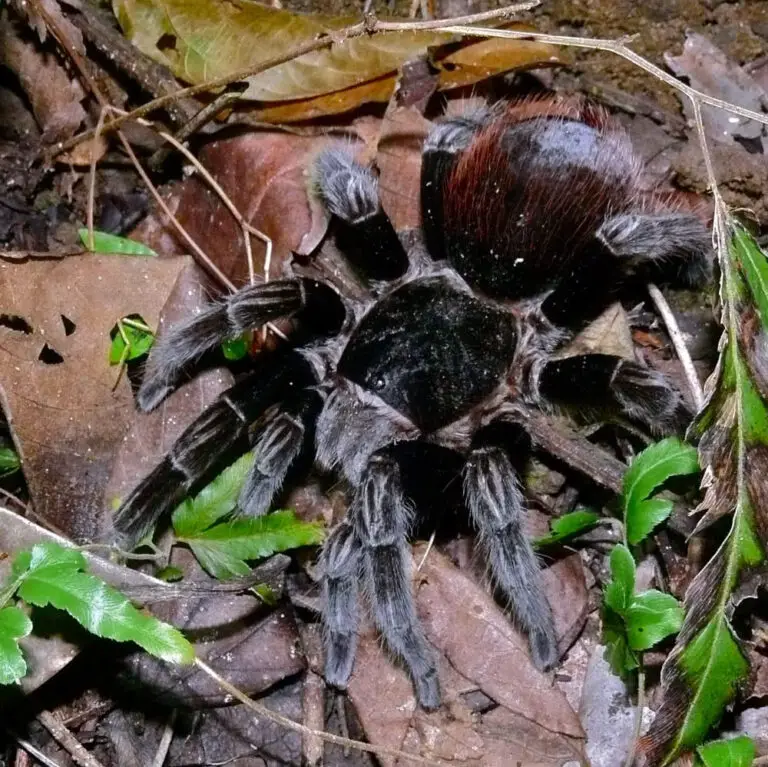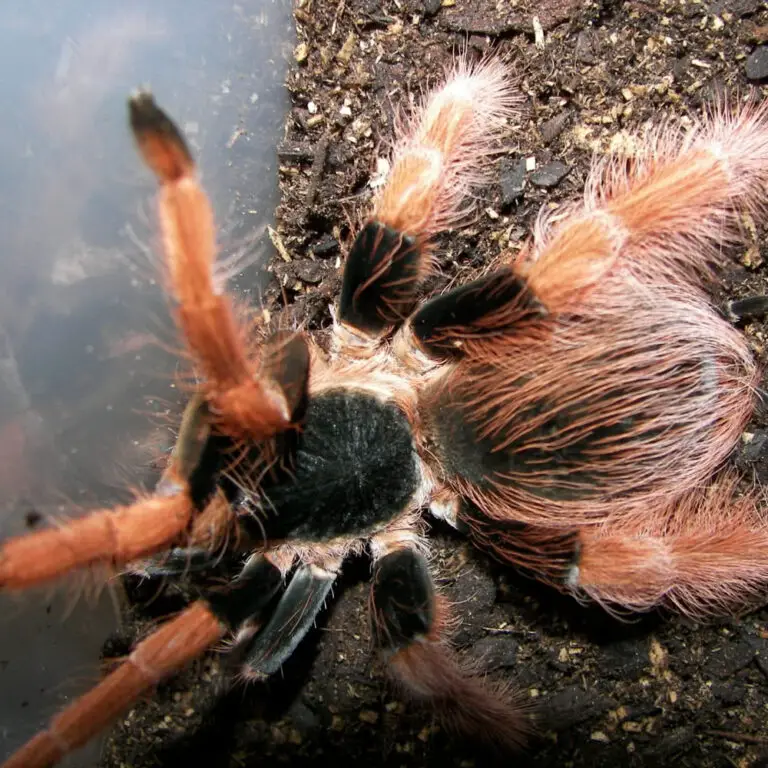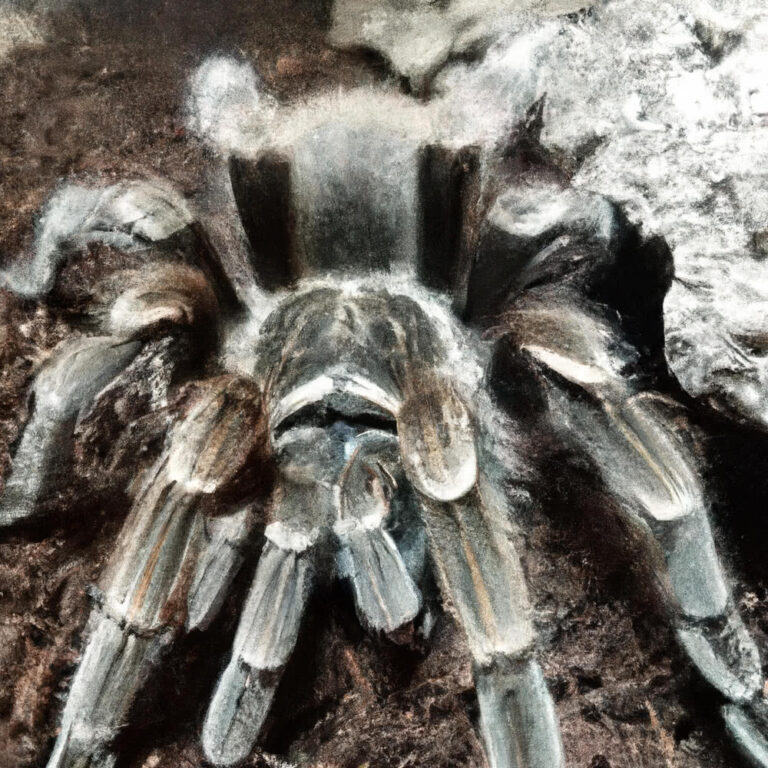The Skeleton Tarantula, scientifically known as Ephebopus murinus, is a species of tarantula found in the rainforests of South America. It is known for its unique skeleton-like patterns on its exoskeleton, which give it its distinctive name. This article will provide an in-depth look at the characteristics, behavior, origin, natural habitat, care, health and diseases, diet and feeding, and breeding of the Skeleton Tarantula.
Characteristics
The Skeleton Tarantula is a medium-sized tarantula with a leg span of around 5 to 6 inches. It has a dark brown body covered with light yellow or white hairs, which create the skeleton-like patterns. The male tarantulas have a more slender body compared to the females. Unlike other tarantulas, the Skeleton Tarantula lacks urticating hairs, which are meant for defense. Instead, it relies on its size and venom to protect itself.
This species of tarantula has a lifespan of around 10 to 15 years in captivity, although some individuals have been known to live up to 20 years. They have a slow growth rate and take several years to reach maturity. The males have a shorter lifespan as they usually die after mating.
Behavior
The Skeleton Tarantula is known to be a relatively calm and docile species. They are usually not aggressive unless provoked. When threatened, they may raise their front legs and display their fangs as a warning. If further provoked, they may use their venomous bite as a defense mechanism.
These tarantulas are primarily terrestrial and burrowing in nature. They are known to create elaborate burrows using their strong legs and fangs. They are more active during the night and spend most of their time hidden in their burrows during the day.
Origin
The Skeleton Tarantula is native to the rainforests of South America, specifically found in countries like Brazil, Guyana, and French Guiana. It is commonly found in the Amazon rainforest and its surrounding areas. It is believed that these tarantulas have evolved to blend in with the leaf litter and forest floor, which helps them hide from predators.
Natural Habitat
The Skeleton Tarantula is primarily found in the tropical rainforests of South America. They inhabit the forest floor and leaf litter, creating burrows under fallen leaves, logs, and other debris. These tarantulas prefer humid and warm environments with temperatures ranging from 75 to 85 degrees Fahrenheit. They require a substrate with adequate humidity to maintain their health.
Care
Proper care is essential for maintaining the health and well-being of the Skeleton Tarantula in captivity. Here are some key care requirements:
- Tank setup: A glass tank with a secure lid is recommended to house the tarantula. The substrate should be a mixture of coco fiber, peat, and sphagnum moss to maintain humidity levels. Provide hiding places like half buried cork bark or tubes.
- Temperature and humidity: Maintain a temperature between 75 to 85 degrees Fahrenheit and humidity levels around 70-80%. This can be achieved by misting the tank regularly and using a hygrometer.
- Feeding: The Skeleton Tarantula is an opportunistic feeder and feeds on a variety of prey including crickets, mealworms, and cockroaches. Offer appropriately sized prey once or twice a week.
- Handling: It is generally recommended not to handle tarantulas as they can be delicate and easily injured. Avoid excessive handling to minimize stress.
Health & Diseases
The Skeleton Tarantula is generally a hardy species and not prone to specific health issues. However, they can be susceptible to common tarantula ailments such as mites, fungal infections, and molting problems. Regular observation and proper care can help prevent and manage these issues.
Diet and Feeding
The Skeleton Tarantula is an insectivore and primarily feeds on a variety of live insects. In captivity, they can be fed a diet consisting of crickets, mealworms, cockroaches, and other appropriately sized prey. It is important to provide a varied diet to ensure balanced nutrition. Feeding should be done once or twice a week, and any uneaten prey should be removed from the tank to avoid contamination.
Breeding
The breeding process of the Skeleton Tarantula begins with the male creating a sperm web. He then performs a courtship dance to attract the female’s attention. If the female is receptive, she will allow the male to mate with her. After mating, the female builds an egg sac and lays her eggs, which she guards until they hatch.
The eggs take around 8 to 10 weeks to hatch into spiderlings. These spiderlings are extremely small and delicate and require special care. They can be kept in small containers with moist substrate and fed on pinhead crickets or fruit flies. As they grow, they will go through several molts until they reach maturity.
Images
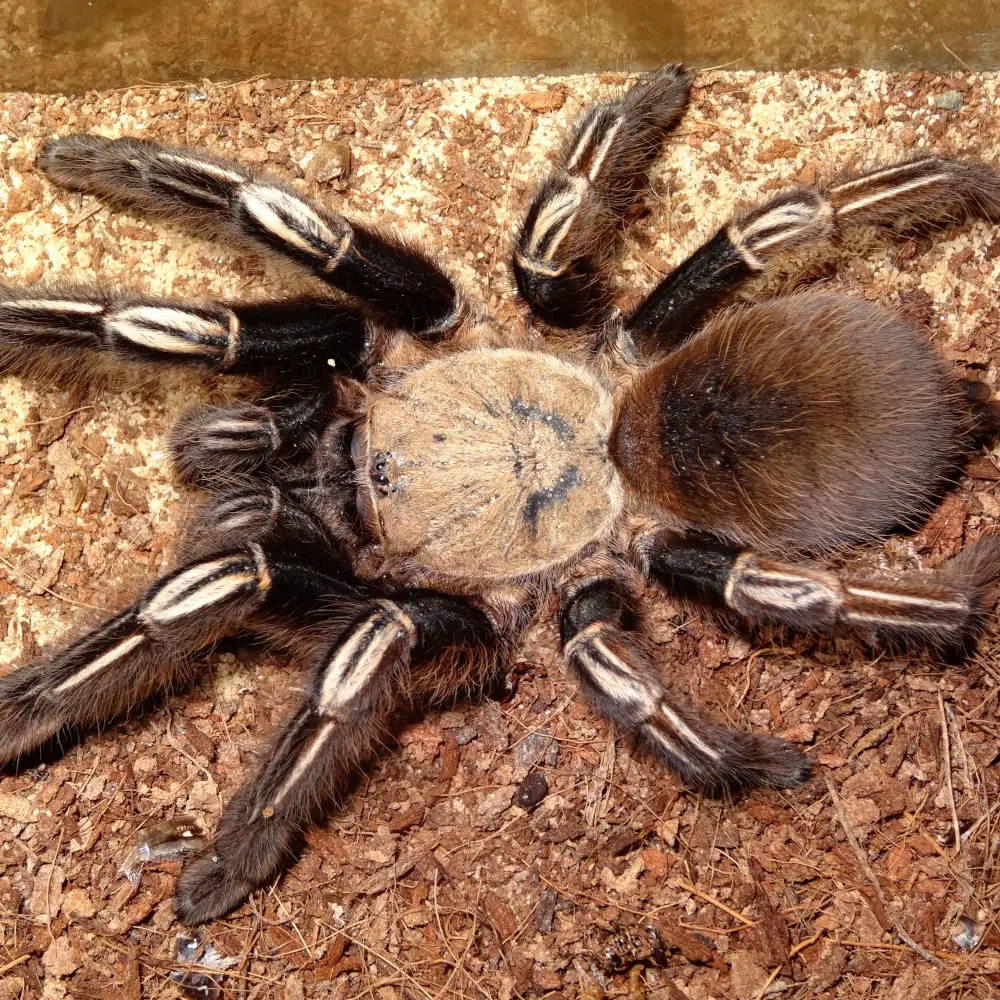
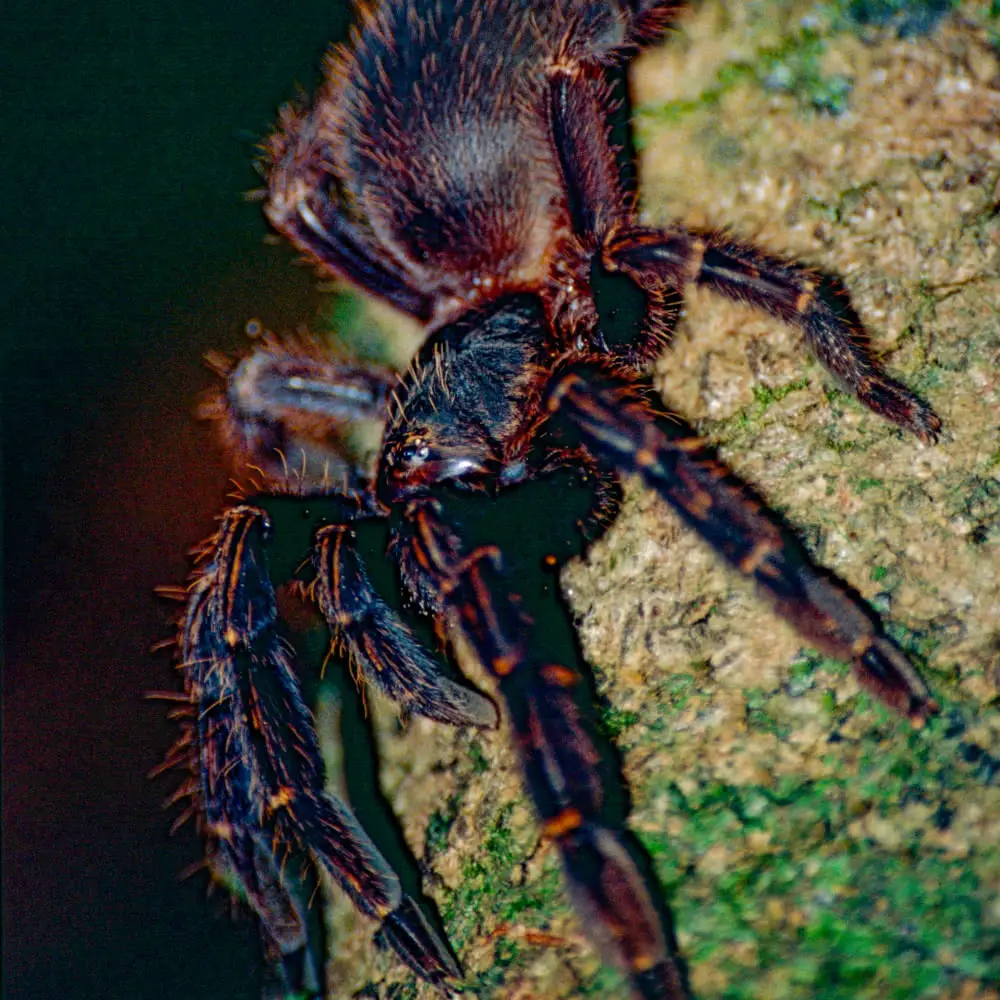
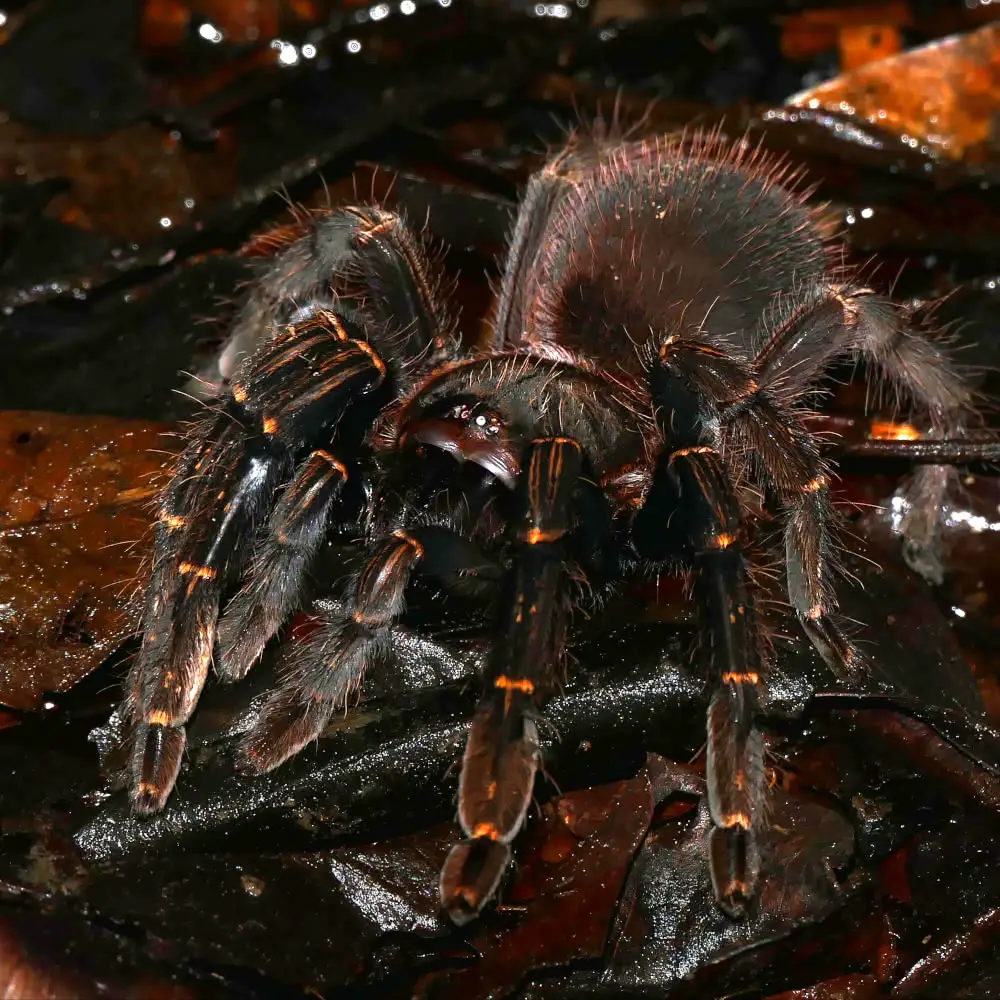
F.A.Q.
What is a skeleton tarantula?
A skeleton tarantula is a species of tarantula known for its unique appearance, which resembles a skeleton.
What is the scientific name of the skeleton tarantula?
The scientific name of the skeleton tarantula is Aphonopelma seemanni.
Where is the skeleton tarantula found in the wild?
The skeleton tarantula is found in the wild in Central America, specifically in Costa Rica and Panama.
How big can a skeleton tarantula get?
A fully grown skeleton tarantula can reach a leg span of 6 to 7 inches (15 to 18 centimeters).
What does the skeleton tarantula look like?
The skeleton tarantula has a black body with white or cream-colored markings, giving it the appearance of a skeleton.
Is the skeleton tarantula venomous?
Yes, the skeleton tarantula is venomous, but its venom is not considered dangerous to humans.
How does the skeleton tarantula catch its prey?
The skeleton tarantula catches its prey by ambushing them, using its stealth and speed to capture insects and small invertebrates.
What does the skeleton tarantula eat?
The skeleton tarantula primarily feeds on insects, such as crickets, roaches, and mealworms.
How often does the skeleton tarantula need to eat?
The skeleton tarantula typically needs to eat once or twice a week to maintain its health and energy.
Can skeleton tarantulas be kept as pets?
Yes, skeleton tarantulas can be kept as pets by tarantula enthusiasts who have the proper knowledge and experience.
How long do skeleton tarantulas live in captivity?
Skeleton tarantulas have a lifespan of around 10 to 15 years in captivity if provided with proper care.
What is the habitat of the skeleton tarantula like?
The habitat of the skeleton tarantula includes dry scrublands, rocky areas, and grassy fields in its native regions.
Does the skeleton tarantula need a specialized enclosure?
While a specialized enclosure is not necessary, the skeleton tarantula’s enclosure should provide the necessary space, ventilation, and security for the spider.
Is the skeleton tarantula aggressive towards humans?
The skeleton tarantula is known for its peaceful temperament and is not typically aggressive towards humans.
Do skeleton tarantulas require special care compared to other tarantulas?
Skeleton tarantulas require similar care to other tarantula species, including providing proper temperature, humidity, and feeding conditions.
Can skeleton tarantulas be housed together?
While some tarantula species can coexist, skeleton tarantulas are best kept individually to avoid potential aggression or stress.
How often should the skeleton tarantula’s enclosure be cleaned?
The enclosure of a skeleton tarantula should be spot cleaned regularly, with a complete cleaning and substrate change every few months.
What temperature and humidity levels are ideal for skeleton tarantulas?
The ideal temperature for skeleton tarantulas is around 75 to 85 degrees Fahrenheit (24 to 29 degrees Celsius), with a humidity level of 60 to 80%.
Can the skeleton tarantula tolerate low temperatures?
The skeleton tarantula cannot tolerate temperatures below 60 degrees Fahrenheit (15 degrees Celsius) for an extended period of time.
Can the skeleton tarantula tolerate high temperatures?
The skeleton tarantula can tolerate temperatures up to 90 degrees Fahrenheit (32 degrees Celsius) as long as there is proper ventilation and hydration.
What substrate should be used in a skeleton tarantula’s enclosure?
A substrate consisting of a mix of coconut fiber, soil, and vermiculite is suitable for a skeleton tarantula’s enclosure.
Do skeleton tarantulas need hiding spots in their enclosure?
Yes, providing hiding spots such as cork bark or half logs is important for the well-being of a skeleton tarantula as it gives them a sense of security.
What type of lighting is necessary for skeleton tarantulas?
Skeleton tarantulas do not require any specific lighting but should have a regular day-night cycle similar to their natural habitat.
How often should a skeleton tarantula be handled?
Handling a skeleton tarantula should be kept to a minimum to reduce stress on the spider. Occasional gentle handling is usually sufficient.
Can skeleton tarantulas be used for educational purposes?
Yes, skeleton tarantulas can be used for educational purposes, including teaching about tarantula biology and behavior.
What are some common health issues seen in skeleton tarantulas?
Common health issues seen in skeleton tarantulas include dehydration, mites, and fungal infections if the enclosure is not properly maintained.
Can skeleton tarantulas regenerate lost limbs?
Yes, skeleton tarantulas have the ability to regenerate lost limbs during the molting process.
Are skeleton tarantulas social creatures?
No, skeleton tarantulas are solitary creatures and do not have a social structure.
What is the temperament of the skeleton tarantula like?
The skeleton tarantula is generally docile and calm, making it a suitable pet for those who prefer a more relaxed tarantula species.
Do skeleton tarantulas have any predators in the wild?
In the wild, skeleton tarantulas may have predators such as birds, reptiles, and small mammals.
Are skeleton tarantulas protected by law?
The legal protection of skeleton tarantulas varies depending on the country and region, so it is important to research and comply with local regulations.
How does the skeleton tarantula defend itself?
The skeleton tarantula can defend itself by using its urticating hairs, kicking them off their abdomen, which can irritate and deter potential threats.
Can skeleton tarantulas swim?
Skeleton tarantulas are not natural swimmers and should be kept away from water sources to prevent drowning.
How does the skeleton tarantula reproduce?
The skeleton tarantula reproduces sexually, with the male depositing a sperm sac that the female then uses to fertilize her eggs.
What is the mating behavior of the skeleton tarantula?
The mating behavior of the skeleton tarantula involves a courtship ritual where the male performs specific movements to entice the female.
How many eggs does a skeleton tarantula lay?
A female skeleton tarantula can lay anywhere between 50 to 200 eggs in a single egg sac.
How long does it take for skeleton tarantula eggs to hatch?
It takes approximately 6 to 8 weeks for skeleton tarantula eggs to hatch into spiderlings.
What is the care for spiderlings of the skeleton tarantula?
Spiderlings of the skeleton tarantula should be kept in small enclosures with moist substrate and provided with small prey items for feeding.
Can skeleton tarantulas be bred in captivity?
Yes, skeleton tarantulas can be bred in captivity with proper planning and preparation.
How often should a skeleton tarantula be fed during breeding?
A skeleton tarantula being bred should be fed slightly more often, with prey offered every 4 to 7 days to ensure optimal health and egg production.
How do you sex a skeleton tarantula?
The sexing of a skeleton tarantula can be done by examining the molted exoskeleton or by examining the structure of the pedipalps.
Are there any morph variations of the skeleton tarantula?
Yes, there are morph variations of the skeleton tarantula, including different patterns and color variations.
Can skeleton tarantulas be hybridized?
Yes, skeleton tarantulas can be hybridized with other species of tarantulas to create new hybrids.
Are skeleton tarantulas difficult to care for as a beginner tarantula?
Skeleton tarantulas are not typically recommended as a beginner tarantula due to their specific care requirements and potential handling challenges.
How expensive are skeleton tarantulas to purchase?
The cost of a skeleton tarantula can vary depending on factors such as age, gender, and rarity, but they are generally in the mid-price range compared to other tarantula species.
Can skeleton tarantulas be exported to other countries?
Exporting skeleton tarantulas to other countries is subject to legal regulations and restrictions, so it is important to research and comply with all relevant laws.
Can skeleton tarantulas be kept communally?
Skeleton tarantulas should not be kept communally as they are solitary creatures and may display aggression towards each other.
How does the skeleton tarantula change as it ages?
As a skeleton tarantula ages, its coloration may fade and become less contrasted, and the spider may grow larger in size.
Can a skeleton tarantula molt in captivity?
Yes, skeleton tarantulas can molt in captivity, and it is a crucial part of their growth and development process.
Can a skeleton tarantula’s diet include pre-killed prey?
Yes, a skeleton tarantula’s diet can include pre-killed prey, such as freeze-dried insects, as long as they are provided with a varied and balanced diet.
Conclusion
The Skeleton Tarantula, with its striking skeleton-like patterns and docile nature, is a fascinating species to keep in captivity. With proper care and attention, these tarantulas can thrive and provide their keepers with years of enjoyment. However, it is important to remember that owning a tarantula is a long-term commitment that requires knowledge and responsibility. As always, it is recommended to do thorough research and consult with experts before bringing any exotic pet into your home.
Image credits:
- https://commons.wikimedia.org/wiki/File:Skeleton_tarantula.jpg
- https://commons.wikimedia.org/wiki/File:Red_Skeleton_Tarantula_%28Ephebopus_rufescens%29_%2810384372273%29.jpg
- https://commons.wikimedia.org/wiki/File:Burgundy_Skeleton_Tarantula_%28Ephebopus_rufescens%29_%28found_by_Sylvain_REMY%29_%2826591818018%29.jpg

